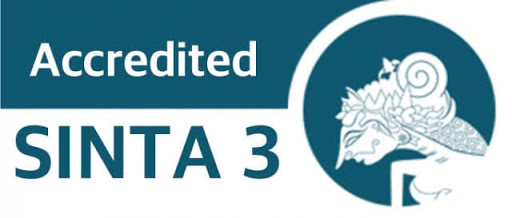IMPROVING STUDENTS’ READING SKILLS THROUGH PUNCTUATIONS BY USING GOOGLE CLASSROOM APPLICATION AT GRADE XII MS 1 OF SMA NEGERI PLUS PROVINSI RIAU
Abstract
The purpose of this research was to explain whether punctuations could better improve the students’ reading skill through google classroom application at grade XII MS 1 of SMA Negeri Plus Provinsi Riau and to explain what factors influenced it. The data were collected by using observation checklists, field notes, and tests. Then, qualitative data were analyzed by data managing, reading or memoing, describing, classifying, and interpreting. Meanwhile, quantitative data were analyzed through the percentage (scores of reading test by using google classroom, matrix, and graph. This classroom action research consisted of two cycles constituting 3 meetings for each cycle. The result of this research showed that implementing google classroom improved the students’ reading skill in each cycles. It was found that at the end of the first cycle, the percentage of the students’ reading skill was 83.20%. However, this result was still unsatisfied. At the end of the second cycle, the improvement of the students’ reading skills after implementing google classroom was 90.40%.. It implied that there was an improvement of the students’ reading skill through punctuations through the implementation of google classroom at the end of second cycle. In conclusion, the use of punctuations improved the students’ reading skills through google classroom application.
Keywords
Full Text:
PDF (English)References
Baugh, L. Sue. (1993). Essentials of English Grammar: A Practical Guide to the Mastery of English (Second Edition). Chicago : Comtemporary Publishing Group,Inc.
Beal, V. (2017). Google Classroom, from Webopedia: http://www.webopedia.com/TERM/G/google-classroom.html,[ April 25,2017]
Bukhori, (2007). ‘The Contribution of Understanding Context Clues and Punctuations toward Reading Skills at English Education Department of UIN Sultan Syarif Kasim Riau”. Unpublished Thesis. Padang: Universitas Negeri Padang.
Chitravelu, N., et.al. (1995). ELT Methodology, Principles and Practice. Selangor Darul Ehsan: Fajar Bhakti Sdn. BHD.
Gillett, A. (2007). Reading Skills for Academic Study. University of Hertfordshire Hatfield. UK: http://www.uefap.com/reading/readfram.html, [june,2018]
Grellet, F. (1999). Developing Reading Skills. Cambridge: Cambridge University Press.
Harris, Albert J. (1980). How to Increase Reading Ability: A Guide to Developmental and Remedial Methods. New York: David McKAy Company Inc.
Hasbaini and Abdul Manan.(2017). Teaching Reading Comprehension by Using Short Stories. English Education Journal, 8(3), 404-423.
Iftakhar, S. (2016). Google Classroom: What Works and How? Journal of Education and Social Sciences, 3(7).
Janzen, M. (2014). Hot team: Google Classroom. Retrieved from The Pennsylvania State University: http://tlt.psu.edu/2014/12/04/hot-team-google-classroom/.
Kemmis, S., and McTaggart, R. (1988). The Action Research Planner (3rded). Victoria: Deakin University Press.
McCaskill, M. K., et.al. (1998). Grammar, Punctuation, and Capitalization. PDF Created from Internet.
Mills, G. E. (2000). Action Research: A Guide for the Teacher Researcher. New Jersey: Prentice-Hall, Inc.
Nurhayati, S. (2019). The Student’s Ability in Using Punctuation and Capitalization through Performing Habit of Writing Diary. INTERACTION: Jurnal Pendidikan Bahasa, 6(2), 11-20. https://doi.org/10.36232/jurnalpendidikanbahasa.v6i2.326
Orwig, C. J. (2007). Reading Skills,dCltrLrnnghttp://www.sil.org/lingualingks/LANGUAGELEARNING/OtherResourses/GudlnsFrALnggAnPrgrm/ReadingSkill.htm, Retrieved on February 2008.
Peck, F. (2007). The Comma. Ottawa. University of Ottawa. http://www.uottawa.ca/academic/arts/writcent/hypergrammar/comma.html#comma,
Stringer, E. (2008). Action Research in Education (2nd Ed). New Jersey: Pearson Education, Inc.
Voeller, E. (1998). Punctuation for Review and Reference: A Style Manual with Exercises. Chicago: Contemporary Publishing Group, Inc.
Wassman, R., and Lee, A. R. (2000). Effective Reading in Changing the World. Singapore: Pearson Asia Pte.Ltd.
Young, R. M. & Harriet, S. (1982). Better Learning. New Jersey: Prentice Hall, Inc.
Zainil. (2006). Actional Functional Model (AFM): Teacher’s Guide for Intermediate Students. Padang: University Negeri Padang Press.
Zainil. (2006). Actional Functional Model (AFM). Padang: Universitas Negeri Padang Press.
DOI: http://dx.doi.org/10.33578/pjr.v4i6.8172
Refbacks
- There are currently no refbacks.
Copyright (c) 2020 JURNAL PAJAR (Pendidikan dan Pengajaran)

This work is licensed under a Creative Commons Attribution-NonCommercial-ShareAlike 4.0 International License.
JURNAL PAJAR (Pendidikan dan Pengajaran)
Secretariat
Program Studi Pendidikan Guru Sekolah Dasar
Gedung B1, FKIP Universitas Riau
Kampus Bina Widya Km. 12,5 Simpang Baru Panam
Pekanbaru Riau Indonesia 28293
e-mail : pajar@ejournal.unri.ac.id



